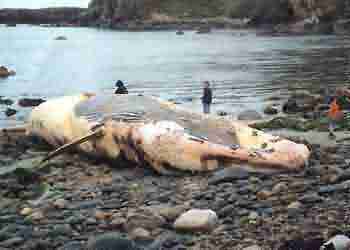Fin whale
(Balaenoptera
physalus)

Geographic distribution
The fin whales
live in every ocean, from the tropics to the polar regions.
They migrate to polar waters in summer for feeding
and return
to warmer seas in winter for breeding.
Characteristics
Only blue
whale is larger than this whale. Its dorsal fin
slopes often backwards. The
flukes are broad and triangular, and
the head is pointed. Its colour is dark-grey
to brown-black, with white undersides. It has
520-950 baleen plates, the largest
of which is 90cm in length. The Fin whale is about 20m
long,
females are generally larger. It weighs between
45-75 tonnes.
It lives approximately 60 years.
Behaviour
Fin whales
are usually seen either in pairs (mother and calf) or
in groups of 6-10 animals, but also
groups of approximately
100 can be found.
The fin whale dives to a maximum of about 300 m. It eats above
all tiny
plankton, but also some fish.

